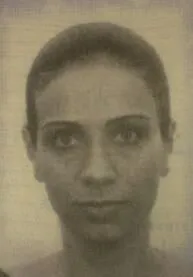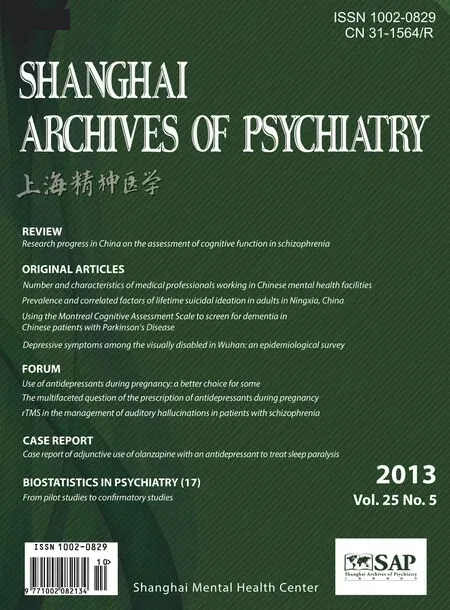rTMS in the management of auditory hallucinations in patients with schizophrenia
Mara Fernandes MARANH?O
?Forum?rTMS for auditory hallucinations
rTMS in the management of auditory hallucinations in patients with schizophrenia
Mara Fernandes MARANH?O
Schizophrenia spectrum disorders can be accompanied by hallucinations in any of the sensory modalities.They are auditory in nature in 70% of cases, resulting in functional disability and a low quality of life.[1,2]The pathophysiological basis of auditory verbal hallucinations (AVH) remains unclear; functional brain imaging studies suggest the involvement of frontal and temporal cortical regions as well as deep brain structures and the limbic system. The regions associated with the perception and production of speech within the temporoparietal (TP) cortex are of particular interest.[3,4]
As discussed in the Forum by Wang and Xu in the last issue of the journal,[5]repetitive transcranial magnetic stimulation (rTMS) has recently emerged as a possible additional tool in the treatment of medication-resistant AVHs. The rationale for its use is that it is a noninvasive intervention that can have prolonged effects on cortical activity (persisting beyond the stimulation period), making it suitable for therapeutic purposes.The majority of studies to date have examined the effects of low frequency rTMS targeted at the left TP area (Brodmann area 40, which is involved in speech perception).[6]A current hypothesis suggests that the potential clinical benefit of rTMS treatment is associated with its inhibition of cortical activity in the speechrelated regions of the brain thought to be pathologically hyperactive during AVH.[2,4,7]Studies published about the use of rTMS to treat AVH have reported both positive and negative results. As pointed out by Slotema and colleagues,[8]most of these studies are underpowered,and those published before 2007 generally had higher effect sizes than those published after 2007. Although larger RCTs published more recently have failed to show a significant effect of rTMS compared to placebocontrolled treatment,[6,9,10]all meta-analyses published to date have concluded that rTMS is more effective than sham treatment.[8,10-16]
There are several gaps in our knowledge about the mechanism of action of rTMS that need to be clarified before its potential application to clinical practice can be fully evaluated. First, the mixed results described above suggest that rTMS does not work equally well for all patients, so it would be useful to identify clinical symptoms or biomarkers that could predict responsiveness to rTMS.[2]To date, little data exists about the individual-based factors associated with responsiveness to rTMS. It has, however, been suggested that responsiveness to rTMS might itself be an indicator of responsiveness to other treatments such as medications.[17]A study by Homan and colleagues[4]assessed changes in resting-brain perfusion in 24 medicated patients with AVH treated with 10 days of 1Hz rTMS (n=12) or theta-burst stimulation (n=12);compared to non-responders the responders had higher regional blood fl ow (CBF) in the left superior temporal gyrus (STG), suggesting that this is a possible biomarker of responsiveness to rTMS in patients with AVH.
Another issue that remains unresolved is determining the optimal method of administration of rTMS. Most studies using rTMS to treat AVH target the left TP cortex.But more recent fMRI studies show considerable intersubject variability in the brain regions activated during AVH, so it’s possible that the optimal focus for rTMS treatment might vary among different patients.[7,18]However, to date, studies targeting other areas than the left TP cortex (including the brain areas that are most active during AVH) do not show improved outcomes.Vercammen and colleagues[6]raised the possibility that bilateral treatment would be more effective because it would affect aspects of hallucinated content that are more closely associated with the right temporal cortex, such as prosody and emotional salience. They tested this hypothesis in a RCT in which 38 patients with medication-resistant AVH were randomly assigned to 1Hz rTMS treatment of the left TP region, 1Hz rTMS treatment of the bilateral TP regions, or placebo(conducted over 6 days, twice daily for 20 min). They found that the frequency of AVH was only significantly reduced in the left rTMS group, but the bilateral rTMS group showed a significant reduction in self-reported affective responsiveness to AVH. Unfortunately, therelatively small samples of such studies makes it impossible to make fi rm conclusions about the potential benefits of rTMS targeted at brain regions other than the left TP.
Additionally, the duration of rTMS effects and the development of efficient maintenance protocols remain a matter of controversy and concern. Long-term followup after rTMS treatment is not commonly reported,and studies that do monitor long-term outcomes have varying results. One recent meta-analysis that identified results for 337 patients found that the effect of rTMS on AVH was no longer significant at one month followup. This short duration of the efficacy of rTMS calls into question its potential utility as a treatment for patients troubled with refractory symptoms.[15]
Future research should also focus on further improvement of rTMS treatment paradigms. Given that relatively infrequent sessions with low frequency rTMS is usually well tolerated, it would be valuable to determine whether or not increasing the intensity and/or number of sessions for individuals who do not respond at the initial level would increase the proportion of individuals who benefit from rTMS and the duration of the rTMS effect.
1. Sommer IE, Koops S, Blom JD. Comparison of auditory hallucinations across different disorders and syndromes.Neuropsychiatry. 2012; 2(1): 1–12.
2. Homan P, Kindler J, Hauf M, Hubl D, Dierks T. Cerebral blood flow identifies responders to transcranial magnetic stimulation in auditory verbal hallucinations. Transl Psychiatry 2012; 2, e189; doi:10.1038/tp.2012.114; published online 20 November 2012.
3. Shergill SS, Brammer MJ, Fukuda R, Willians SCR, Murray RM, McGuire PK. Engagement of brain areas implicated in processing inner speech in people with auditory hallucinations. Br J Psychiatry 2003; 182(6): 525-531.
4. Homan P, Kindler J, Hauf M, Walther S, Hubl D, Dierks T.Repeated measurements of cerebral blood flow in the left superior temporal gyrus reveal tonic hyperactivity in patients with auditory verbal hallucinations: a possible trait marker. Front Hum Neurosci 2013; 7: 304. doi: 10.3389/fnhum.2013.00304. eCollection 2013.
5. Wang JJ, Xu YF. Should repetitive Transcranial Magnetic Stimulation (rTMS) be considered an effective adjunctive treatment for auditory hallucinations in patients with schizophrenia? Shanghai Archives of Psychiatry 2013; 25(4):254-255.
6. Vercammen A, Knegtering H, Bruggeman R, Westenbroek HM, Jenner JA, Slooff CJ et al. Effects of bilateral repetitive transcranial magnetic stimulation on treatment resistant auditory-verbal hallucinations in schizophrenia: a randomized controlled trial. Schizophr Res 2009; 114: 172–179.
7. Hoffman RE, Boutros NN, Berman RM, Roessler E, Belger A, Krystal JH, et al. Transcranial magnetic stimulation of the left temporoparietal cortex in three patients reporting hallucinated ‘voices’. Biol Psychiatry 1999; 46(1): 130-132.
8. Slotema CW, Aleman A, Daskalakis ZJ, Sommer IE. Metaanalysis of repetitive transcranial magnetic stimulation in the treatment of auditory verbal hallucinations: update and effects after one month. Schizophr Res 2012; 142(1-3): 40-45.
9. Loo CK, Sainsbury K, Mitchell P, Hadzi-Pavlovic D, Sachdev PS. A sham-controlled trial of left and right temporal rTMS for the treatment of auditory hallucinations. Psychol Med 2010; 40(4): 541–546.
10. Slotema CW, Blom JD, de Weijer AD, Diederen KM,Goekoop R, Looijestijn J, et al. Can low-frequency repetitive transcranial magnetic stimulation really relieve medicationresistant auditory verbal hallucinations? Negative results from a large randomized controlled trial. Biol Psychiatry 2011; 69(5): 450-456.
11. Freitas C, Fregni F, Pascual-Leone A. Meta-analysis of the effects of repetitive transcranial magnetic stimulation(rTMS) on negative and positive symptoms in schizophrenia.Schizophr Res 2009; 108(1-3): 11-24.
12. Demeulemeester M, Amad A, Bubrovszky M, Pins D,Thomas P, Jardri R. What is the real effect of 1-Hz repetitive transcranial magnetic stimulation on hallucinations?Controlling for publication bias in neuromodulation trials.Biol Psychiatry 2012; 71(6): e15-16.
13. Tranulis C, Sepehry AA, Galinowski A, Stip E. Should we treat auditory hallucinations with repetitive transcranial magnetic stimulation? A metaanalysis. Can J Psychiatry 2008; 53(9):577-586.
14. Aleman A, Sommer IE, Kahn RS. Efficacy of slow repetitive transcranial magnetic stimulation in the treatment of resistant auditory hallucinations in schizophrenia: a metaanalysis. J Clin Psychiatry 2007; 68(3): 416-421.
15. Burt T, Lisbany SH, Sackeim HA. Neuropsychiatry applications of transcranial magnetic stimulation: a meta-analysis. Int J Neuropsychopharmacol 2002; 5(10): 73-103.
16. Slotema CW, Blom JD, Hoek HW, Sommer IE. Should we expand the toolbox of psychiatric treatment methods to include Repetitive Transcranial Magnetic Stimulation (rTMS)?A meta-analysis of the efficacy of rTMS in psychiatric disorders. J Clin Psychiatry 2010; 71(7): 873-884. doi:10.4088/JCP.08m04872gre. Epub 2010 Mar 9.
17. Poulet E, Brunelin J, Kallel L, Bediou B, Dalery J, D’amato T, et al. Is rTMS efficient as a maintenance treatment for auditory verbal hallucinations? A case report. Schizophr Res 2006;84(1): 183-184. doi: 10.1016/j.schres.2006.02.014. Epub 2006 Mar 31.
18. Diederen KMJ, Charbonnierl, Neggers SFW , van Lutterveld R, Daalman K, Slotema CW, et al. Reproducibility of brain activation during auditory verbal hallucinations. Schizophr Res 2013; 146: 320–325.
10.3969/j.issn.1002-0829.2013.05.009
Department of Psychiatry, Universidade Federal de S?o Paulo - Escola Paulista de Medicina (Unifesp-EPM), S?o Paulo, Brazil
correspondence: mfmaranhao@yahoo.com.br

Dr. Maranh?o completed her medical degree at the Unversidade Estadual Paulista (UNESP) in 2006 and her residency in psychiatry at the Escola Paulista de Medicina in 2010. She is currently a postgraduate student in psychiatry at the Univerisdade Federal de S?o Paulo (UNIFESP) working in a multidisciplinary outpatient programme for patients with eating disorders (PROATA).
- 上海精神醫(yī)學(xué)的其它文章
- From pilot studies to confirmatory studies
- Case report of adjunctive use of olanzapine with an antidepressant to treat sleep paralysis
- The multifaceted question of the prescription of antidepressants during pregnancy
- Use of antidepressants during pregnancy: a better choice for some
- Depressive symptoms among the visually disabled in Wuhan:an epidemiological survey
- Using the Montreal Cognitive Assessment Scale to screen for dementia in Chinese patients with Parkinson’s disease

